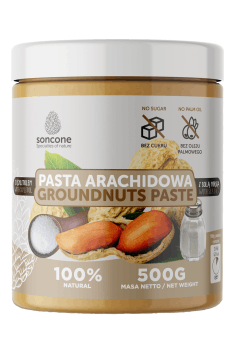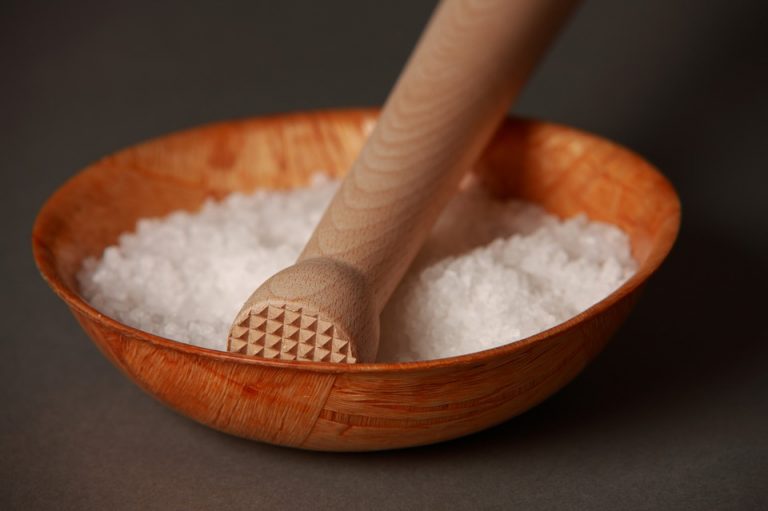Salt is the most infamous seasoning in the world. Recommendations such as “limit the salt intake” or “avoid salt” are common and commonly accepted. Some people even came up with the “salt phobia” and will not add salt even to the blandest tasting meal.
Salt guidelines. How much salt shoudl you eat?
Developed in 2010 dietary guidelines for Americans Department of Agriculture said, that you should not consume more than 2300mg of sodium a day. For people after 50 years of age, as well as people with high pressure, diabetes or chronic kidney disease, these recommendations are even smaller: up to 1500mg of sodium per day.
In Poland, the Food and Nutrition Institute (FNI) appeals for the reduction of salt (sodium chloride) intake in press release from March 2016:
- up to 5 g per day (one flat teaspoon) for adults,
- to 1.9 g - 3.75 g per day for children and adolescents.
The recommendations concerns not only salt, which we add to our food, but also the one contained in ready food meals.
Important: The amount of salt and sodium are two different parameters, FNI said, that 1g of sodium (Na) is equal to 2,5g of salt (NaCl).
FNI warns, that excessive consumption of salt leads to serious diseases, such as: high blood pressure, strokes, heart attacks, stomach cancer, kidney stones, osteoporosis, obesity, traumatic brain injury and dementia. According to FNI, Polish people consume an average of 10-15g of salt per day, which is twice or three times more than the safe amount.
To make it easier to balance a quantity of salt consumed daily, FNI provides the amount in specific product types.
What contains salt? In which food there is the most amount of salt?

Amount of salt (NaCl). Source of information: “Tables of composition and nutritional value of food”, FNI’s own research:
- Vegetable seasoning with salt (bouillon cubes, so called universal seasoning powder) 21.52 - 70.84g / 100g.
- Vegetable products (ketchup, pickled cucumbers, pickled vegetables, olives): 0.08 - 6.00 g / 100g.
- Processed cheese, feta-type cheese: 2.10 - 2.75g / 100g.
- Rennet cheeses ripening: 1.46 - 4.65g / 100g.
- Smoked pork, beef, mixed: 1.75 - 3.89g / 100g.
- Smoked poultry: 1.15 - 3.02g / 100g.
- Offal: 1.56 - 2.66g / 100g.
- Smoked fish: 1.25 - 3.68g / 100g.
- Fish: 0.58 - 2.73g / 100g.
- Potato Chips: 1.73 - 2.15g / 100g.
- Breakfast products (processed): 0.01 - 2.92g / 100g.
- Mayonnaise, mustard: 0.99 - 1.90g / 100g.
- Bread: 0.32 - 1.78g / 100g.
IOM and WHO salt-related guidelines
The recommendations of the US Department of Agriculture and the Polish FNI are therefore a bit convergent. As well as the World Health Organisation (WHO) with their recommendation to reduce salt intake down to 5g NaCl per day, or up to 2g of sodium, fits into this trend. There is a clear consensus. Against this background, the report from Institute of Medicine (IOM) from May 2013 looks very interesting (currently it’s The National Academies of Sciences, Engineering, and Medicine in Washington, DC): “Sodium intake in population. Assessment of evidence”.
Scientists from IOM analysed the existing studies on the harmfulness of salt to the health, and came to the conclusion that the results of these studies are not consistent, they expressed doubt towards their quality and noticed many methodological limitations.
IOM report regarding salt impact on health
IOM commission concludes, that
there is evidence of a link between higher sodium intake and the risk of cardiovascular disease
However, they also state, that the
research regarding the effects on health are inconsistent and there is not enough of it to be able to define if sodium intake below 2300mg per day increases or decreases the risk of heart diseases, strokes and overall mortality.
Some studies suggest, that low sodium consumption may lead to increased risk of negative effects on health in patients with congestive heart failure, undergoing aggressive treatment.
IOM didn’t find any evidence for health benefits of reducing sodium intake to 1500-2300mg per day in people with diabetes, kidney diseases, cardiovascular diseases or people who are over 50 years old. Studies that suggested this were found to have methodological errors.
The Commission further concluded that, although the available literature provides some evidence of adverse health effects of low sodium intake among people with diabetes, chronic kidney disease or pre-existing cardiovascular disease, evidence of both the benefits and of the damage are not strong enough to indicate that these subgroups should be treated differently than the general population of the United States.
IOM did not agree to support the recommendations of lowering the sodium intake to a maximum of 1500mg per day for these people.
Salt impact on health - summary
Therefore, IOM supports efforts to reduce excessive salt intake to reduce the risk of heart disease and stroke. They did not, however, found scientific evidence to determine what level of salt intake should be regarded as excessive. Scientists from the institute even point to the fact, that determining a recommended, specific level of salt intake is a major challenge, because there are too many variables at stake that can decide this. They pay attention to the fact, that this recommended daily intake would have to be different for different groups of people.






